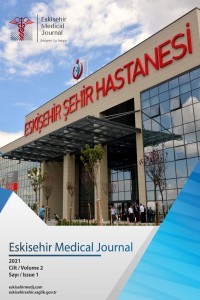COVID-19 Salgını Sırasında Sağlık Profesyonelleri Tarafından Kullanılan Koruyucu Yüz Maskelerinin Rahatlığı ve Tolere Edilebilirliğinin Değerlendirilmesi
İş Sağlığı, Kişisel koruyucu donanım, COVID-19, Yüz maskesi, Solunum Koruması/Solunum Cihazları
Comfort and tolerability of protective face masks used by healthcare professionals during the COVID-19 pandemic
Occupational Health, Personal protective equipment, COVID-19, Face mask, Respiratory Protection/Respirators,
___
- References 1. Huang, C., Y. Wang, X. Li, L. Ren, et al., Clinical features of patients infected with 2019 novel coronavirus in Wuhan, China. Lancet, 2020. 395(10223): p. 497-506.
- 2. COVID-19 Dashboard. 2021 [cited 2021 September]; Available from: https://gisanddata.maps.arcgis.com/apps/dashboards/bda7594740fd40299423467b48e9ecf6.
- 3. Paules, C.I., H.D. Marston, and A.S. Fauci, Coronavirus Infections-More Than Just the Common Cold. JAMA, 2020. 323(8): p. 707-708.
- 4. Osseiran, N. WHO calls for healthy, safe and decent working conditions for all health workers, amidst COVID-19 pandemic. 2020 [cited 2021 May]; Available from: https://www.who.int/news/item/28-04-2020-who-calls-for-healthy-safe-and-decent-working-conditions-for-all-health-workers-amidst-covid-19-pandemic.
- 5. WHO, Rational use of personal protective equipment for coronavirus disease (COVID-19) and considerations during severe shortages, in COVID-19: Infection prevention and control, W. Headquarters, Editor. 2020.
- 6. NIOSH. COVID-19 Information for Workers. 2018 [cited 2021 April]; Available from: https://www.cdc.gov/niosh/index.htm.
- 7. Wizner, K., M. Nasarwanji, E. Fisher, A.L. Steege, and J.M. Boiano, Exploring respiratory protection practices for prominent hazards in healthcare settings. J Occup Environ Hyg, 2018. 15(8): p. 588-597.
- 8. Zhang, X., H. Li, S. Shen, and M. Cai, Investigation of the flow-field in the upper respiratory system when wearing N95 filtering facepiece respirator. J Occup Environ Hyg, 2016. 13(5): p. 372-82.
- 9. Gillespie, C. Does Wearing a Face Mask Reduce Oxygen—and Can It Increase CO2 Levels? Here's What Experts Say. 2020 [cited 2021 April]; Available from: https://www.health.com/condition/infectious-diseases/coronavirus/does-wearing-face-mask-increase-co2-levels.
- 10. Johnson, A.T., Respirator masks protect health but impact performance: a review. J Biol Eng, 2016. 10: p. 4.
- 11. Scarano, A., F. Inchingolo, and F. Lorusso, Facial Skin Temperature and Discomfort When Wearing Protective Face Masks: Thermal Infrared Imaging Evaluation and Hands Moving the Mask. Int J Environ Res Public Health, 2020. 17(13).
- 12. Siegel, J.D., E. Rhinehart, M. Jackson, L. Chiarello, and C. Health Care Infection Control Practices Advisory, 2007 Guideline for Isolation Precautions: Preventing Transmission of Infectious Agents in Health Care Settings. Am J Infect Control, 2007. 35(10 Suppl 2): p. S65-164.
- 13. Rosner, E., Adverse Effects of Prolonged Mask Use among Healthcare Professionals during COVID-19. Journal of Infectious Diseases and Epidemiology, 2020. 6: p. 130.
- 14. Coronavirus disease (COVID-19): Masks. 2020 [cited 2021 April]; Available from: https://www.who.int/news-room/q-a-detail/coronavirus-disease-covid-19-masks.
- 15. Kumar, S. and A. Singh, Prolonged Use of n95 Mask a Boon or Bane to Healthcare Workers During Covid-19 Pandemic. Indian J Otolaryngol Head Neck Surg, 2021: p. 1-4.
- 16. Derrick, J.L. and C.D. Gomersall, Protecting healthcare staff from severe acute respiratory syndrome: filtration capacity of multiple surgical masks. J Hosp Infect, 2005. 59(4): p. 365-8.
- 17. Improve How Your Mask Protects You. About COVID-19. 2021 [cited 2021 April]; Available from: https://www.cdc.gov/coronavirus/2019-ncov/your-health/effective-masks.html.
- 18. World Health Organization. Coronavirus Disease (COVID-19) Advice for the Public: Myth Busters. 2020 [cited 2021 April]; Available from: https://www.who.int/emergencies/diseases/novel-coronavirus-2019/advice-for-public/myth-busters.
- 19. Considerations for Wearing Cloth Face Coverings. 2020 [cited 2021 April]; Available from: https://www.cdc.gov/coronavirus/2019-ncov/prevent-getting-sick/cloth-face-cover-guidance.html.
- 20. Ipek, S., S. Yurttutan, U.U. Gullu, T. Dalkiran, et al., Is N95 face mask linked to dizziness and headache? Int Arch Occup Environ Health, 2021.
- 21. Smith, C.L., J.L. Whitelaw, and B. Davies, Carbon dioxide rebreathing in respiratory protective devices: influence of speech and work rate in full-face masks. Ergonomics, 2013. 56(5): p. 781-90.
- 22. Geiss, O., Effect of Wearing Face Masks on the Carbon Dioxide Concentration in the Breathing Zone. Aerosol Air Qual. Res., 2021. 21(200403).
- ISSN: 2718-0948
- Yayın Aralığı: Yılda 3 Sayı
- Başlangıç: 2020
- Yayıncı: Eskişehir Şehir Hastanesi
Akut konjestif kalp yetmezliğine neden olan dev sol atriyum: bir olgu sunumu
Murat DUYAN, Serhat GÜNLÜ, Ali SARIDAŞ, Resmiye Nur OKUDAN, İbrahim Ulaş ÖZTURAN
Zeynel Mert ASFUROĞLU, Ahmet KÜÇÜK, Nusret KÖSE
Pediatrik Hidrosefali Olgularında Şant Revizyonlarının Değerlendirilmesi
Adem KURTULUŞ, Ayhan TEKİNER, Halil KUL, Yavuz ERDEM, Haydar ÇELİK, Mehmet Emre YILDIRIM, Mehmet Akif BAYAR
Murat DUYAN, İbrahim Ulaş ÖZTURAN, Mustafa Ayhan OZBEK, Hüseyin SEVIL, Ökkeş ZORTUK, Resmiye Nur OKUDAN, Fatih SELVİ, Aslıhan Yürüktümen ÜNAL, Yıldıray ÇETE
Hasan İNAL, Zeynep OZTURK INAL, İlknur KÜÇÜKOSMANOĞLU, Meryem İlkay EREN KARANİS
COVID-19 ve Ruh Sağlığı: Güncel Araştırmalar Bize Ne Gösteriyor?
Gamze GÜRCAN, Şükrü Alperen KORKMAZ, Şule BIÇAKCI AY, Ahmet GÜRCAN
Hatice Mine ÇAKMAK, Yaşar BİLDİRİCİ, Fuzuli TUĞRUL, Meral BAHAR, Murat BALOĞLU, Müge GÜNDOĞDU
Metastatik Nüks Osteosarkomda Sorafenib Kullanımı: Olgu Sunumu
Hatice Mine ÇAKMAK, Yaşar BİLDİRİCİ, Funda ÇORAPCIOĞLU, Harzem ÖZGER, Ayten KAYI CANGIR, Meral BAHAR
Yan Ağrısı ile Nadir Bir Başvuru Nedeni: Retroperitoneal Fibrozis
Gülşah UÇAN, Mustafa Emin ÇANAKÇI, Ömer Erdem ŞEVİK, Ruhi CÜRE, Ata ÖZEN
